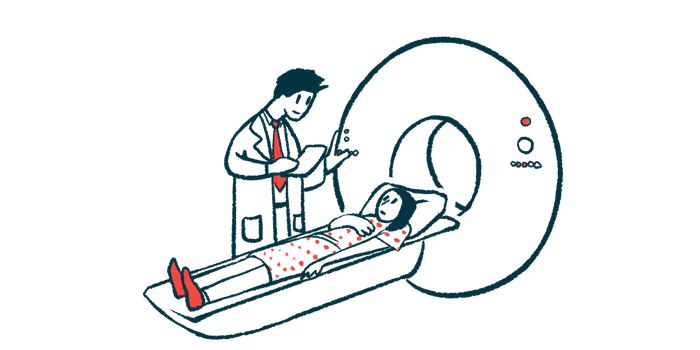New asymptomatic lesions don’t shorten time to NMOSD relapses
'Relatively frequent' lesions do not increase risk of relapse, study suggests
Written by |

Nearly two in 10 neuromyelitis optica spectrum disorder (NMOSD) patients develop new asymptomatic brain and spinal cord lesions during the period of disease remission, but these do not appear to increase risk of relapse, according to a study in Argentina.
Asymptomatic, or silent, lesions are those that can be seen on magnetic resonance imaging (MRI) scans, but do not cause overt symptoms.
These findings suggest that “new asymptomatic lesions are relatively frequent” among people with NMOSD, the researchers wrote, but were not associated with “a shorter time to developing subsequent relapses.”
The study, “Frequency of new asymptomatic MRI lesions during attacks and follow-up of patients with NMOSD in a real-world setting,” was published in the Multiple Sclerosis Journal.
NMOSD is a neuroautoimmune condition characterized by abnormal immune and inflammatory attacks that damage mainly the optic (eye) nerves and the spinal cord, causing a range of vision and movement problems.
Each relapse, or attack, of NMOSD causes new neurological damage that builds up over time and leads to patients experiencing either new symptoms or the return of symptoms they had before.
Increasing evidence shows that some patients have asymptomatic lesions in MRI scans, and these have been reported during relapses and in relapse-free periods.
“Nevertheless, the exact role of new asymptomatic or silent lesions on MRI has not been fully elucidated with regard to prognosis, treatment failure, risk of subsequent relapses, or disease management,” the researchers wrote.
Analyzing the evolution of these lesions over time after an initial attack “may improve our understanding on subclinical activity of the disease and may help to plan specific strategies for monitoring disease activity and treatment,” they added.
Reviewing MRI scans of NMOSD patients
To know more, a team of researchers in Argentina looked back at MRI scans of 135 NMOSD patients who had at least two years of clinical and MRI follow-up data since disease onset.
All were participating in RevelarEM (NCT03375177), a nationwide registry of people with NMOSD or multiple sclerosis, a related neuroautoimmune condition.
Patients’ mean age was 46.5 years, most (76.3%) were women, and they had been living with the disease for a mean of 8.3 years. Nearly two-thirds (64.4%) tested positive for anti-AQP4 antibodies, the most common type of self-reactive antibodies that can drive NMOSD.
The patients had experienced a total of 262 relapses and a total of 675 MRI scans were available: 225 conducted during an attack and 450 taken during the relapse-free period, at least three months from a previous attack.
The researchers found that 26 (19.3%) of patients experienced at least one new asymptomatic lesion during the relapse-free period. The most common locations for these lesions were the optic nerves (38.5%) and the spinal cord (23.1%).
There were no significant differences in terms of demographic information, antibody status, and treatments between patients with and without new asymptomatic lesions, and statistical analyses did not find any predictors for these lesions.
The team also found no significant group differences in the time it took for a new relapse to occur or in the risk of subsequent relapses, suggesting these silent lesions may not predict future relapses.
Lesions most commonly affected optic nerves
Also, 66 patients (48.9%) had at least one new asymptomatic lesion during relapses, meaning that the lesions were unrelated to patients’ clinical symptoms or signs. These lesions most commonly affected the optic nerves (25.8%) and the spinal cord (13.6%).
Again, no significant differences in demographics, antibody status, and treatment were found between patients with and without asymptomatic lesions during relapses.
The results indicate that while new asymptomatic lesions appear to be common in people with NMOSD, having these lesions during a relapse-free period does not mean patients will have another relapse shortly after.
“The presence of new silent MRI lesions during the [non-relapse period] and at relapses does not seem to be a concern, as these findings were not associated with a shorter time to developing subsequent relapses,” the researchers wrote.
Contradictory findings
Notably, these findings are in contrast with those of the Phase 2/3 N-MOmentum trial (NCT02200770), which tested Uplizna (inebilizumab) against a placebo in NMOSD patients.
Trial data analyses showed that the presence of asymptomatic spinal cord lesions was associated significantly with spinal cord-related NMOSD attacks in the following year. No such link was found for asymptomatic lesions in the optic nerve.
Larger studies, following patients receiving similar treatments and conducting MRI scans at regular intervals and with similar parameters “are needed to assess the generalizability of our conclusions,” the researchers wrote.
This information may help in “determining whether performing MRI outside of relapses (at follow-up) as a complementary subclinical activity control in NMOSD patients is relevant in clinical practice, especially in the current era of newly approved immunotherapies,” they concluded.






